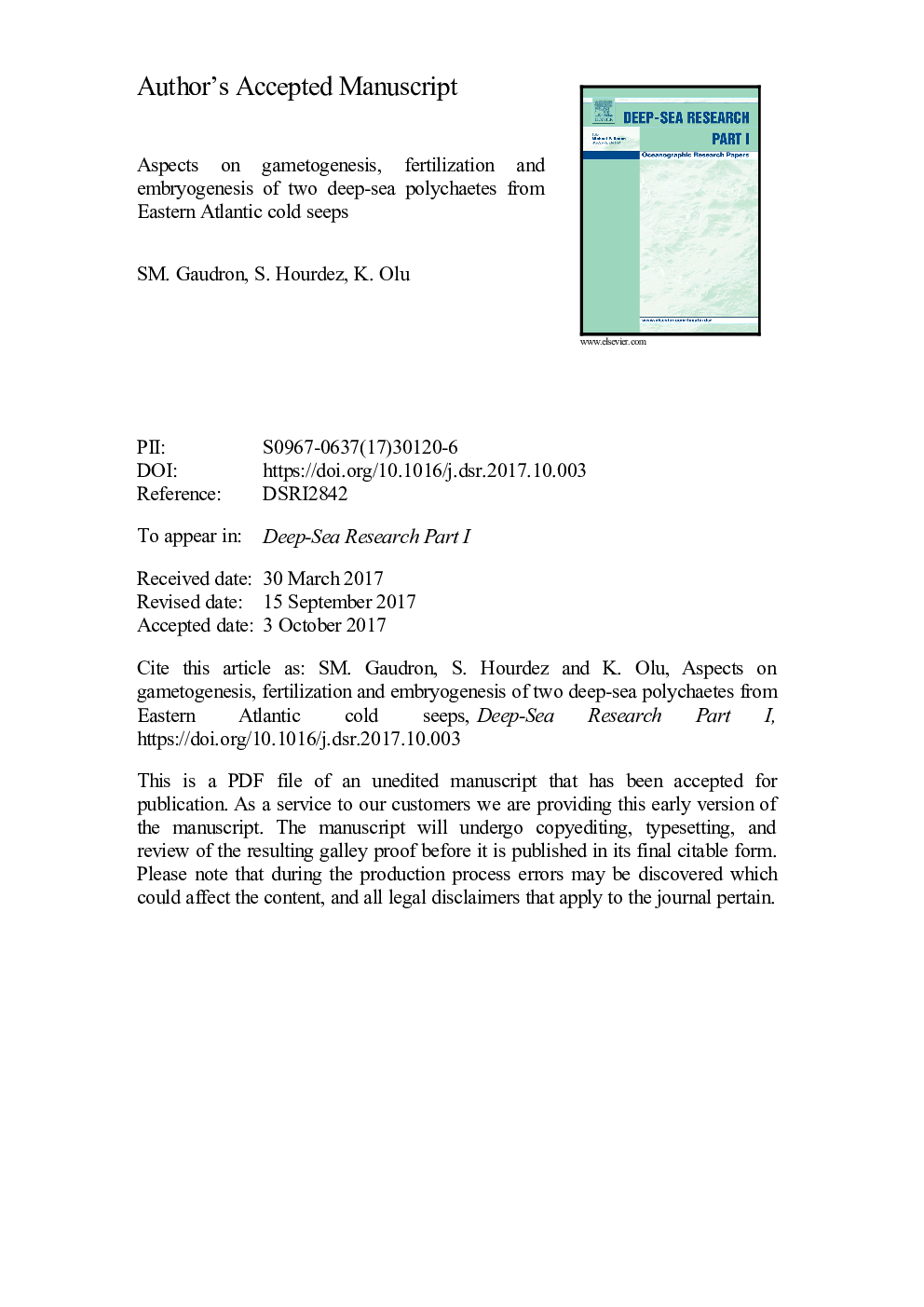| کد مقاله | کد نشریه | سال انتشار | مقاله انگلیسی | نسخه تمام متن |
|---|---|---|---|---|
| 8884323 | 1626301 | 2017 | 30 صفحه PDF | دانلود رایگان |
عنوان انگلیسی مقاله ISI
Aspects on gametogenesis, fertilization and embryogenesis of two deep-sea polychaetes from Eastern Atlantic cold seeps
ترجمه فارسی عنوان
جنبه های گامتوژنز، لقاح و جنین زایی دو پلی اتیلن دریای عمیق از آبی اقیانوس اطلس
دانلود مقاله + سفارش ترجمه
دانلود مقاله ISI انگلیسی
رایگان برای ایرانیان
کلمات کلیدی
موضوعات مرتبط
مهندسی و علوم پایه
علوم زمین و سیارات
زمین شناسی
چکیده انگلیسی
We investigated two gonochoristic species of annelid polychaetes (one siboglinid and one polynoid) from cold seeps that ranged from 525 m to 3300 m in depth (Guiness, Worm Hole and Regab pockmarks) on the Gabon and Congo continental margins (Gulf of Guinea). Different aspects of gametogenesis (oocyte diameter, presence of ovisac, spermatozoa shape, and fecundity), fertilization (in vitro fertilization experiments: IVF) and embryogenesis (cleavage rate) were studied. The sampled siboglinid was a new species of Lamellibrachia and the second population of this genus in the Eastern Atlantic. Mean oocyte diameter was about 100 µm and fully-grown primary oocytes were stored in an ovisac, as in other studied siboglinids. The presence of a single spermatozoon was noted within an oviduct, indicating a possible internal fertilization. The rate of cell division at 6 °C was one cleavage every ~20 h. Embryos developed normally to the blastula stage after 5-d post-fertilization at atmospheric pressure suggesting some pressure tolerance. The second polychaete was the scale-worm Branchipolynoe cf. seepensis that lives in commensalism in the mantle cavity of Bathymodiolus aff. boomerang. Anatomical reproductive features were similar to those described in B. seepensis from hydrothermal vents on Mid-Atlantic Ridge, with lecithotrophic larval development and continuous gametogenesis. We performed the first IVF carried out on gametes for any deep-sea polynoid species. Fertilization and development occurred but a number of abnormalities were observed demonstrating a limitation to embryogenesis at atmospheric pressure. The rate of cell division was three times faster at 8 °C than at 4 °C with a maximum stage of 8-cells reached after 72 h post-fertilization. We surprisingly observed some oocytes from the negative seawater control during IVF experiments cleaved to the 2-cell stage, demonstrating the possible occurrence of internal fertilization prior to IVF experiment or the accidental release of sperm from the female's spermatheca.
ناشر
Database: Elsevier - ScienceDirect (ساینس دایرکت)
Journal: Deep Sea Research Part I: Oceanographic Research Papers - Volume 129, November 2017, Pages 59-68
Journal: Deep Sea Research Part I: Oceanographic Research Papers - Volume 129, November 2017, Pages 59-68
نویسندگان
S.M. Gaudron, S. Hourdez, K. Olu,
